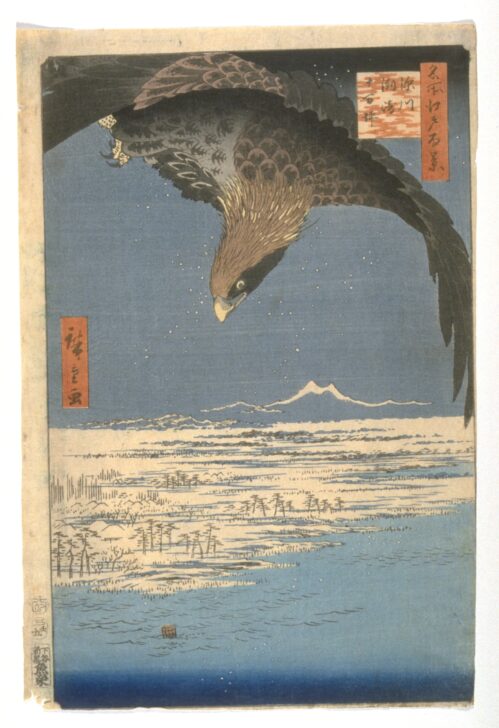One Hundred Famous Views of Edo: #107 Fukagawa, Susaki and the Jumantsubo Plain
Utagawa Hiroshige

Description
In this print, the bokashi technique is used near the edge of the sky and along the bottom edge of the water of the Edo Bay. This print is also a fine example of Hiroshige’s unique style of composition, which he developed in his later print series. Here, the bird and the landscape are framed almost as two separate views, with the foreground element dramatically enlarged. The unusual perspective allows the viewer to share the soaring eagle’s point
of view as it flies over the vast plain below.
From Spring/Summer 2015 Gallery Rotation
---------
Plate 107 from the Meisho edo Hyakkei (One-Hundred Famous Views of Edo) series
The artist uses the flying eagle’s point of view to present the scene of the wide plain dotted with trees and Mt. Fuji in the background. The majestic depth and breadth of the plain are ingeniously illustrated with this unique perspective.
----
While Andô Hiroshige established his reputation as a landscape artist, he was also known for prints in the genre of bird-and-flower painting. Over the course of his career he completed an estimated 5,000 studies of birds and flowers.
Hiroshige was in his sixties when he embarked upon the series One Hundred Famous Views of Edo (Meisho Edo Hyakkei), which combines his mastery of landscapes and bird-and-flower painting, while incorporating innovative compositions and color choices. This print is perhaps one of the best examples of his use of striking figure-ground framing techniques. Here, the viewer is positioned alongside a black kite, or tonbi, circling the sky above the twin peaks of Mount Tsukuba. In Japan the tonbi is understood as an inexorable hunter and scavenger, and its favorite food is fabled to be thin pieces of fried tofu. This tonbi may be after a floating crate of fried tofu below or the smaller birds flocking around it.
(Japanese Gallery Rotation, Spring 2009)
Subject Matter:
In this series Hiroshige combines his mastery of kacho-e and landscapes, while incorporating innovative compositions and color choices. His use of vertical format literally turned ukiyo-e on its side, transforming the traditional horizontal structure of woodblock prints. He also makes use of striking figure-ground framing techniques, of which this print, Fukugawa, Ten-million Tsubo Plain at Suzaki, may be the most famous example.
The viewer is positioned alongside a black kite, or tonbi, circling the sky above the twin peaks of Mount Tsukuba. In Japanese culture the tonbi is understood as an inexorable hunter and scavenger, and her favorite food is fabled to be abura age, or thin pieces of fried tofu. This tonbi may be after a floating crate of abura age below or the smaller birds flocking around it.
Physical Description:
This vertical print frames a view of a landscape with an up close view of a bird in the upper right corner that takes up about thirty percent of the image.
The viewer is positioned alongside the bird, circling the sky above the twin peaks of a mountain. A crate floats in the water below while smaller birds flocking around it. Snow covers the ground.
The signature and title markings are in the upper right corner, and in the middle along the left side above the landscape.
Usage Rights:
If you are interested in using an image for a publication, please visit https://umma.umich.edu/request-image/ for more information and to fill out the online Image Rights and Reproductions Request Form.